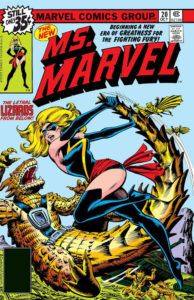 True Believers: Captain Marvel — The New Ms. Marvel #1 (of 1) — Writer: Chris Claremont; Pencils: Dave Cockrum; Inks: Bob Wiacek; Colors: Mary Ellen
True Believers: Captain Marvel — The New Ms. Marvel #1 (of 1) — Writer: Chris Claremont; Pencils: Dave Cockrum; Inks: Bob Wiacek; Colors: Mary Ellen
True Believers: Captain Marvel — Avenger #1 (of 1) — Writer: David Michelinie; Pencils: John Byrne; Inks: Klaus Janson; Colors: Sharen
True Believers: Captain Marvel — Betrayed! #1 (of 1) — Writer: Chris Claremont; Pencils: Michael Golden; Inks: Armando Gil; Colors: Michael Golden
Captain Marvel: Braver and Mightier #1 (of 1) — Writer:  Jody Houser; Art: Simone Buonfantino; Colors: Erick Arciniega
Jody Houser; Art: Simone Buonfantino; Colors: Erick Arciniega
The Captain Marvel movie debuts next week, and Marvel’s certainly ready: they’ve been publishing their “True Believer” $1 reprints of her (and, in a few cases, her male predecessor) all month, relaunched her ongoing series, and now this week offer a one-shot, too. The three final “True Believer” books feature, first, 1978’s Ms. Marvel #20, which showcased a new costume for her, and a Chris Claremont/Dave Cockrum story that has Claremont’s usual focus on character, heroism and a feminist perspective much more advanced than most company comics of that 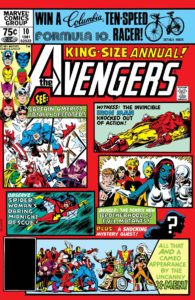 period. Next is 1979’s Avengers #183, which has Carol Danvers joining that franchise team, and is the first part of a nice-looking John Byrne/Klaus Janson art job with the Absorbing Man as villain. Finally, there’s Avengers Annual #10, from 1981. Claremont does the scripting, and, among other things (like the first appearances of Rogue and Madeline Pryor, early ones of Mystique and Destiny, and a Michael Golden art job) fixes one of the ickiest episodes of Marvel history — the Avengers #200 issue where Danvers left the group after being, basically, brainwashed and raped by Kang’s kid — with the Avengers being totally OK with that (no, really — although the creators of the story didn’t see it that way; however, Claremont’s
period. Next is 1979’s Avengers #183, which has Carol Danvers joining that franchise team, and is the first part of a nice-looking John Byrne/Klaus Janson art job with the Absorbing Man as villain. Finally, there’s Avengers Annual #10, from 1981. Claremont does the scripting, and, among other things (like the first appearances of Rogue and Madeline Pryor, early ones of Mystique and Destiny, and a Michael Golden art job) fixes one of the ickiest episodes of Marvel history — the Avengers #200 issue where Danvers left the group after being, basically, brainwashed and raped by Kang’s kid — with the Avengers being totally OK with that (no, really — although the creators of the story didn’t see it that way; however, Claremont’s 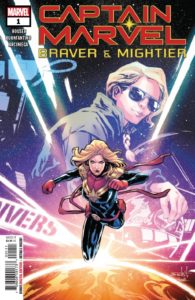 speech by Danvers in this issue rakes all the Avengers — and, by extension, that early story’s producers — over the coals for it). As an annual, it’a double-sized, too — but still just a buck in this week’s reprint: obviously the bargain of the week, especially if you’re a Captain Marvel fan. The new issue, Captain Marvel: Braver and Mightier — has her fighting an alien invasion single-handedly while getting in some backstory and looking at her effect on ordinary people; it’s a stand-alone tale that spotlights her considerable powers, offers some full-page splashes of her in action, and makes her sympathetic and admirable: exactly what you want on the stands to attract fans from that upcoming film.
speech by Danvers in this issue rakes all the Avengers — and, by extension, that early story’s producers — over the coals for it). As an annual, it’a double-sized, too — but still just a buck in this week’s reprint: obviously the bargain of the week, especially if you’re a Captain Marvel fan. The new issue, Captain Marvel: Braver and Mightier — has her fighting an alien invasion single-handedly while getting in some backstory and looking at her effect on ordinary people; it’s a stand-alone tale that spotlights her considerable powers, offers some full-page splashes of her in action, and makes her sympathetic and admirable: exactly what you want on the stands to attract fans from that upcoming film.
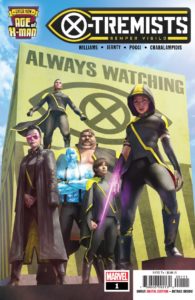 Age of X-Man: X-Tremists #1 (of 5) — Writer: Leah Williams; Pencils: Georges Jeany; Inks: Roberto Poggi; Colors: Jim Charalampidis
Age of X-Man: X-Tremists #1 (of 5) — Writer: Leah Williams; Pencils: Georges Jeany; Inks: Roberto Poggi; Colors: Jim Charalampidis
Daredevil #2 (Legacy #614) — Writer: Chip Zdarsky; Art: Marco Checchetto; Colors: Sunny Gho
Invaders #2 — Writer: Chip Zdarsky; Art: Carlos Magno with Butch Guice; Colors: Alex Guimaraes
Savage Sword of Conan #2 (Legacy #237) — Writer: Gerry Duggan; Art: Ron Garney; Colors: Richard Isanove
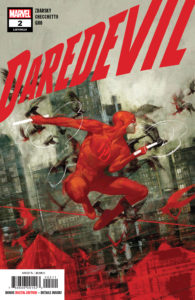 Marvel Comics Presents #2 — Creators: Various
Marvel Comics Presents #2 — Creators: Various
A first issue and a bunch of second ones: Age of X-Man: X-Tremists continues the connected stories of the alternate-future mutant utopia created by Nate Grey; this comic’s team (Psylocke, Iceman, Jubilee, Northstar and a much-different-looking Blob) hunts down mutants who’ve broken their society’s restrictions against love/physical passion. Leah Williams (probably best known to Marvel fans for her recent X-book one-shots X-Men Black: Emma Frost and the What If? featuring Magik) does a good job with the team banter (making them relatable) contrasted with their totalitarian mission, and Georges Jeanty, who drew most of 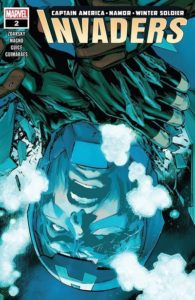 the original Dark Horse Buffy the Vampire Slayer comics back in the day, is good at distinguishing the many characters involved, and making them interesting. Chip Zdarsky offers two sophomore issues: Daredevil #2 sees Matt back in costume after an almost-fatal injury, and maybe having accidentally killed a perp during a fight — or was it a frame-up by his enemies? Part of Zdarsky’s talent is that we honestly don’t know; between that, a new adversary in the form of a strait-laced new NYPD officer, and a dramatic cliffhanger ending, the book seems in good hands. Zdarsky’s other book, The Invaders, is a modern-day re-uniting of that original WWII-era team of Captain America, the original android Human Torch, Bucky and Prince Namor, the Sub-Mariner; right now, everyone’s trying to
the original Dark Horse Buffy the Vampire Slayer comics back in the day, is good at distinguishing the many characters involved, and making them interesting. Chip Zdarsky offers two sophomore issues: Daredevil #2 sees Matt back in costume after an almost-fatal injury, and maybe having accidentally killed a perp during a fight — or was it a frame-up by his enemies? Part of Zdarsky’s talent is that we honestly don’t know; between that, a new adversary in the form of a strait-laced new NYPD officer, and a dramatic cliffhanger ending, the book seems in good hands. Zdarsky’s other book, The Invaders, is a modern-day re-uniting of that original WWII-era team of Captain America, the original android Human Torch, Bucky and Prince Namor, the Sub-Mariner; right now, everyone’s trying to 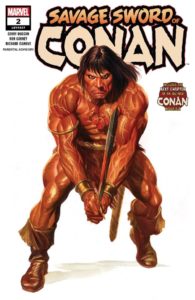 reason with Namor, who’s gotten into one of his dark Atlantis-against-the-surface-world moods — but there are hints that something’s wrong with his head, making him crazy/murderous instead of righteous. Carlos Magno and Butch Guice contribute a solid superhero-realist style like Mike Deodato’s or Steve Epting’s, and this is one of those books that, if they can just get people to sample it, will probably convince them to stick around; sample it yourself, and see. “Solid” is a good description of the new Savage Sword of Conan, too — Gerry Duggan and Ron Garney don’t do blow-your-head-off game-changing retcons or special effects, but offer an above-average, professional barbarian sword-and-sorcery tale that should satisfy fans of the surly Cimmerian. Marvel Comics Presents, like its
reason with Namor, who’s gotten into one of his dark Atlantis-against-the-surface-world moods — but there are hints that something’s wrong with his head, making him crazy/murderous instead of righteous. Carlos Magno and Butch Guice contribute a solid superhero-realist style like Mike Deodato’s or Steve Epting’s, and this is one of those books that, if they can just get people to sample it, will probably convince them to stick around; sample it yourself, and see. “Solid” is a good description of the new Savage Sword of Conan, too — Gerry Duggan and Ron Garney don’t do blow-your-head-off game-changing retcons or special effects, but offer an above-average, professional barbarian sword-and-sorcery tale that should satisfy fans of the surly Cimmerian. Marvel Comics Presents, like its 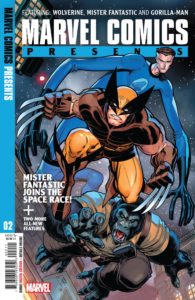 1980s predecessor, is an anthology title that prominently features Wolverine: the cover story is part two of a Charles Soule/Paulo Siqueira/Oren Junior serial about a demon that has to be exorcised every ten years; part one saw our hero battling him during WWII, and this installment picks up his return in 1954. Mark Waid and Djibril Morissette-Phan offer a one-shot Mr. Fantastic story set a few years before the formation of the FF and their trip into space; as with all Wade tales, it’s thoughtful, continuity-conscious and well-told. Finally, David (Stray Bullets) Lapham and wife Maria contribute a Gorilla Man/Black Panther team-up that, as you might expect from Lapham’s pedigree, does well by one of Marvel’s oldest, if also mostly obscure, characters.
1980s predecessor, is an anthology title that prominently features Wolverine: the cover story is part two of a Charles Soule/Paulo Siqueira/Oren Junior serial about a demon that has to be exorcised every ten years; part one saw our hero battling him during WWII, and this installment picks up his return in 1954. Mark Waid and Djibril Morissette-Phan offer a one-shot Mr. Fantastic story set a few years before the formation of the FF and their trip into space; as with all Wade tales, it’s thoughtful, continuity-conscious and well-told. Finally, David (Stray Bullets) Lapham and wife Maria contribute a Gorilla Man/Black Panther team-up that, as you might expect from Lapham’s pedigree, does well by one of Marvel’s oldest, if also mostly obscure, characters.
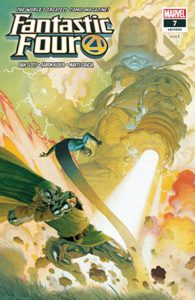 Fantastic Four #7 (Legacy #652) — Writer: Dan Slott; Art: Aaron Kuder with John Lucas; Colors: Marte Gracia with Rachelle Rosenberg
Fantastic Four #7 (Legacy #652) — Writer: Dan Slott; Art: Aaron Kuder with John Lucas; Colors: Marte Gracia with Rachelle Rosenberg
Avengers: No Road Home #3 (Legacy #710) — Writers: Al Ewing, Jim Zub and Mark Waid; Pencils: Paco Medina; Inks: Juan Vlasco; Colors: Jesus Aburtov
Captain America #8 (Legacy #712) — Writer: Ta-Nehisis Coates; Art: Adam Kubert; Colors: Frank Martin
Amazing Spider-Man #16 (Legacy #817) — Writer: Nick  Spencer; Pencils: Ryan Ottley and Alberto Albuquerque; Inks: Cliff Rathburn and Alberto Albuquerque; Colors: Laura Martin, Brian Reber and Carlos Lopez
Spencer; Pencils: Ryan Ottley and Alberto Albuquerque; Inks: Cliff Rathburn and Alberto Albuquerque; Colors: Laura Martin, Brian Reber and Carlos Lopez
Superior Spider-Man #3 — Writer: Christos Gage; Pencils: Mike Hawthorne; Inks: Wade von Grawbadger; Colors: Jordie Bellaire
West Coast Avengers #8 — Writer: Kelly Thompson; 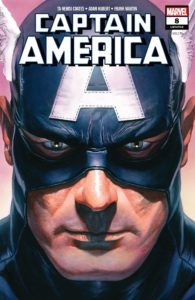 Art/Colors: Gang Hyuk Lim
Art/Colors: Gang Hyuk Lim
Fantastic Four benefits from a striking Alex Ross-like cover from Esad Ribic; the inside story, a middle chapter in a Doctor Doom/Galactus/FF match, mostly lives up to it (it would be disappointing if both Doom and Galactus got bumped back to their default settings, but author Dan Slott showed during his long Amazing Spider-Man tenure that he could wring a lot of changes out of a book’s central concepts, and still make it consistent with both continuity and character, so I’m willing to at least wait until the end of the story to 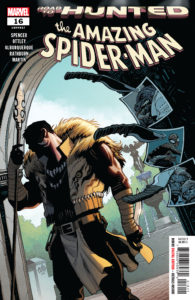 pass judgment). Avengers: No Road Home sees everyone split into groups to chase scattered power shards coveted by the Big Bad — a classic set-up, and one that allows plenty of character bits: of Rocket Raccoon, the Hulk and Hawkeye in a nightmare realm, and of Hercules, Scarlet Witch, Vision and Spectrum searching in a shining city/library “at the center of infinity”; for its weekly 10% of the over-story, it moves things along entertainingly enough. Captain America‘s also in the middle of an arc, a Cap-in-prison set-up that showcases Ta-Nehisi Coates’s careful plotting and
pass judgment). Avengers: No Road Home sees everyone split into groups to chase scattered power shards coveted by the Big Bad — a classic set-up, and one that allows plenty of character bits: of Rocket Raccoon, the Hulk and Hawkeye in a nightmare realm, and of Hercules, Scarlet Witch, Vision and Spectrum searching in a shining city/library “at the center of infinity”; for its weekly 10% of the over-story, it moves things along entertainingly enough. Captain America‘s also in the middle of an arc, a Cap-in-prison set-up that showcases Ta-Nehisi Coates’s careful plotting and 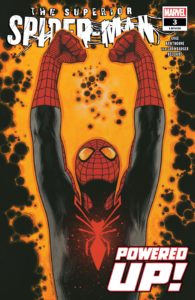 character work, and Adam Kubert’s solid figures and page designs. Amazing Spider-Man is the issue before a ten-part weekly Avengers-No-Road-Home-like event called “Hunted,” starring (of course) Kraven the Hunter; there’s an editorial page talking about the art lineup, but someone, either the designer or the editor, decided to write it in red ink against a black background in tiny print, so it’s all but illegible, although I’m pretty sure I saw Humberto Ramos and Chris Bachalo’s names in there somewhere…. Over in Superior Spider-
character work, and Adam Kubert’s solid figures and page designs. Amazing Spider-Man is the issue before a ten-part weekly Avengers-No-Road-Home-like event called “Hunted,” starring (of course) Kraven the Hunter; there’s an editorial page talking about the art lineup, but someone, either the designer or the editor, decided to write it in red ink against a black background in tiny print, so it’s all but illegible, although I’m pretty sure I saw Humberto Ramos and Chris Bachalo’s names in there somewhere…. Over in Superior Spider-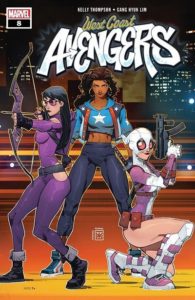 Man, the first arc concludes (in only three issues, a welcome trend after all those interminable six-issue for-the-trade series starts) with a cosmic-powered Doctor Octo-Spidey fighting former Galactus herald Terrax, and demonstrating enough heroism to get his supporting cast, not to mention the book’s readers, to stick around and see how his new status quo works out. West Coast Avengers continues being a confident, fun Young Avengers-ish YA book, integrating superhero action, relationship drama, humor and an interesting, diverse cast with crisp modern mangaish art: just the kind of storytelling to eke out a long life in Scholastic or regular trade collections.
Man, the first arc concludes (in only three issues, a welcome trend after all those interminable six-issue for-the-trade series starts) with a cosmic-powered Doctor Octo-Spidey fighting former Galactus herald Terrax, and demonstrating enough heroism to get his supporting cast, not to mention the book’s readers, to stick around and see how his new status quo works out. West Coast Avengers continues being a confident, fun Young Avengers-ish YA book, integrating superhero action, relationship drama, humor and an interesting, diverse cast with crisp modern mangaish art: just the kind of storytelling to eke out a long life in Scholastic or regular trade collections.
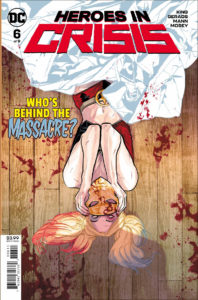 Heroes In Crisis #6 (of 9) — Writer: Tom King; Art: Mitch Gerads with Clay Mann; Colors: Mitch Gerads and Tomeu Morey
Heroes In Crisis #6 (of 9) — Writer: Tom King; Art: Mitch Gerads with Clay Mann; Colors: Mitch Gerads and Tomeu Morey
Flash #65 — Writer: Joshua Williamson; Pencils: Rafa Sandoval; Inks: Jordie Tarragona; Colors: Tomeu Morey
Action Comics #1008 — Writer: Brian Michael Bendis; Art: Steve Epting; Colors: Brad Anderson
Hex Wives #5 — Writer: Ben Blacker; Art: Mirka Andolfo; Colors: Marissa Louise
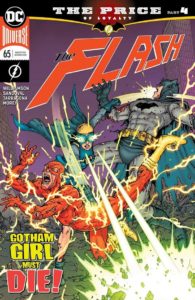 In Heroes In Crisis #6, longtime Tom King collaborator Mitch Gerads steps in to do much of the art — not a bad thing at all, given the quality of their work together. It’s episode six of nine, so nothing major is revealed — but we get Harley and Ivy scenes, more of King’s patented D-list character analysis laced with humor and pathos (this time involving Bronze Age Teen Titan/caveman Gnarrk), and puzzle pieces of the murder mystery involving Wally West, Roy Harper and Booster Gold — Wally, especially. His death also echoes over in Flash #65, the conclusion of a four-part crossover with Batman; it affects the relationships between Bruce, Barry and Iris, and
In Heroes In Crisis #6, longtime Tom King collaborator Mitch Gerads steps in to do much of the art — not a bad thing at all, given the quality of their work together. It’s episode six of nine, so nothing major is revealed — but we get Harley and Ivy scenes, more of King’s patented D-list character analysis laced with humor and pathos (this time involving Bronze Age Teen Titan/caveman Gnarrk), and puzzle pieces of the murder mystery involving Wally West, Roy Harper and Booster Gold — Wally, especially. His death also echoes over in Flash #65, the conclusion of a four-part crossover with Batman; it affects the relationships between Bruce, Barry and Iris, and  there’s a near-future flash-forward at the end that teases how it will all impact DC’s next event, “The Year of the Villain.” The company’s been smart about connecting all of this together into a meta-narrative that’s intriguing, and feels important enough, for fans to follow. Events in Action Comics are no doubt connected to the whole thing, too, as the “Leviathan Rising” saga hits its stride with that shadowy world-ruling organization taking out a number of major players, involving both Amanda Waller and General Lane; we also get his daughter Lois back at the Daily Planet, a paranoid Jimmy Olson, and a number of other moving parts, all very smoothly delivered by Steve Epting’s
there’s a near-future flash-forward at the end that teases how it will all impact DC’s next event, “The Year of the Villain.” The company’s been smart about connecting all of this together into a meta-narrative that’s intriguing, and feels important enough, for fans to follow. Events in Action Comics are no doubt connected to the whole thing, too, as the “Leviathan Rising” saga hits its stride with that shadowy world-ruling organization taking out a number of major players, involving both Amanda Waller and General Lane; we also get his daughter Lois back at the Daily Planet, a paranoid Jimmy Olson, and a number of other moving parts, all very smoothly delivered by Steve Epting’s  ultra-competent drawings and Brian Michael Bendis’s plot- and dialogue-stuffed scripts: his transition to DC seems to be paying off in a big way. Hex Wives, as a Vertigo title, doesn’t have to worry about all that company-wide event stuff; it can continue to tell its own self-contained Stepford Wives-ish tale of suburban housewives who are much more than they seem, but don’t know it. After a number of build-up issues, this week they finally do know it, and the discovery gooses the action and pays off well — especially with Mirka (Unnatural) Andolfo’s precise, eye-catching art; this book’s combination of magic and #MeToo offers just the kind of modern fable that the Vertigo imprint was formed to deliver.
ultra-competent drawings and Brian Michael Bendis’s plot- and dialogue-stuffed scripts: his transition to DC seems to be paying off in a big way. Hex Wives, as a Vertigo title, doesn’t have to worry about all that company-wide event stuff; it can continue to tell its own self-contained Stepford Wives-ish tale of suburban housewives who are much more than they seem, but don’t know it. After a number of build-up issues, this week they finally do know it, and the discovery gooses the action and pays off well — especially with Mirka (Unnatural) Andolfo’s precise, eye-catching art; this book’s combination of magic and #MeToo offers just the kind of modern fable that the Vertigo imprint was formed to deliver.
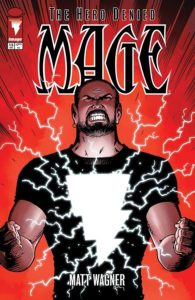 Mage: The Hero Denied #15 (of 15) — Writer/Artist: Matt Wagner; Colors: Brennan Wagner
Mage: The Hero Denied #15 (of 15) — Writer/Artist: Matt Wagner; Colors: Brennan Wagner
The Wicked and the Divine #42 — Writer: Kieron Gillen; Art: Jamie McKelvie; Colors: Matthew Wilson
Buffy the Vampire Slayer #2 — Writer: Jordie Bellaire; Art: Dan Mora; Colors: Raul Angulo
The Avant-Guards #2 — Writer: Carly Usdin; Art: Noah Hayes; Colors: Rebecca Nalty
 Man-Eaters #6 — Writer: Chelsea Cain; Pencils: Kate Niemczyk; Colors: Rachelle Rosenberg
Man-Eaters #6 — Writer: Chelsea Cain; Pencils: Kate Niemczyk; Colors: Rachelle Rosenberg
Hellboy and the B.P.R.D.: 1956 #4 — Story: Mike Mignola and Chris Roberson; Art: Mike Norton, Michael Avon Oeming and Yishan Li; Colors: Dave Stewart
Rick and Morty #47 — Writer: Kyle Starks; Art: Puste; Colors: Sarah Stern
 Mage concludes Matt Wagner’s 35-year-long trilogy with 64 pages of story (including a climactic quadruple foldout), an eight-page letters section, and the appropriate bittersweet musing by Wagner himself; if you’ve ever read any of the episodes, from 1984’s debut until now, then this is worth a look: not many creators have had the stamina or the talent to craft a story across that much time and space, and have it end so well. The Wicked and the Divine is on issue #42 out of 45, and the last few issues have been a flood of twists and revelations, some based on groundwork laid years ago;
Mage concludes Matt Wagner’s 35-year-long trilogy with 64 pages of story (including a climactic quadruple foldout), an eight-page letters section, and the appropriate bittersweet musing by Wagner himself; if you’ve ever read any of the episodes, from 1984’s debut until now, then this is worth a look: not many creators have had the stamina or the talent to craft a story across that much time and space, and have it end so well. The Wicked and the Divine is on issue #42 out of 45, and the last few issues have been a flood of twists and revelations, some based on groundwork laid years ago; 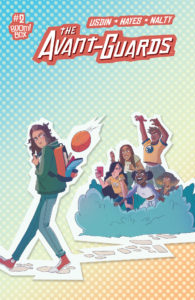 that’s what happens when pros like Kieron Gillen and Jamie McKelvie craft a long-form story like this, and it’s doubled fun for fans who’ve stuck around for their monthly installment during all that time. Buffy the Vampire Slayer is a reboot back to her high-school origins, and this second issue shows that characters won’t necessarily show up in the same order or say the same things that fans of the original series remember; that’s a good thing, since no creator wants to be just a puppet mouthing a decades-old script, and readers don’t want the same old scenes over and
that’s what happens when pros like Kieron Gillen and Jamie McKelvie craft a long-form story like this, and it’s doubled fun for fans who’ve stuck around for their monthly installment during all that time. Buffy the Vampire Slayer is a reboot back to her high-school origins, and this second issue shows that characters won’t necessarily show up in the same order or say the same things that fans of the original series remember; that’s a good thing, since no creator wants to be just a puppet mouthing a decades-old script, and readers don’t want the same old scenes over and 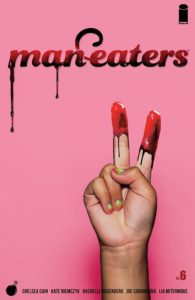 over either — even if they think they do. The Avant-Guards is a typical Boom! offering — YA-friendly, charmingly drawn, diverse, fascinating in its look at art-school college girls trying to form a basketball team with the help of a promising newcomer, and with just a hint of magic realism to stir the pot: these are exactly the books that are inspiring the young comics creators of the next few decades, and we should all appreciate them for it. Man-Eaters’s high-concept sf hook is that, in its near-future setting, most girls have been infected with a virus that, if they begin menstruation, turns
over either — even if they think they do. The Avant-Guards is a typical Boom! offering — YA-friendly, charmingly drawn, diverse, fascinating in its look at art-school college girls trying to form a basketball team with the help of a promising newcomer, and with just a hint of magic realism to stir the pot: these are exactly the books that are inspiring the young comics creators of the next few decades, and we should all appreciate them for it. Man-Eaters’s high-concept sf hook is that, in its near-future setting, most girls have been infected with a virus that, if they begin menstruation, turns  them into savage were-panthers, and that society’s reaction to this is… well, not all that different from how a lot of cultures, and men in power, treat menstruating women anyway. The sf aspect’s been taking a back seat to the social satire so far, and that continues in this issue; the world-building, which has gotten both increasingly detailed and more sardonic, is fun, although at some point the tension’s going to have to be released with a big bloody action sequence — and I trust both writer Chelsea Cain and artist Kate Niemczyk to deliver the payoff it deserves. Hellboy and the B.P.R.D.: 1956, while set in that year, has
them into savage were-panthers, and that society’s reaction to this is… well, not all that different from how a lot of cultures, and men in power, treat menstruating women anyway. The sf aspect’s been taking a back seat to the social satire so far, and that continues in this issue; the world-building, which has gotten both increasingly detailed and more sardonic, is fun, although at some point the tension’s going to have to be released with a big bloody action sequence — and I trust both writer Chelsea Cain and artist Kate Niemczyk to deliver the payoff it deserves. Hellboy and the B.P.R.D.: 1956, while set in that year, has  plenty of connections to the current post-apocalypse world in the B.P.R.D.’s regular book, especially in its look at the Russian demon/child Varvara, and how she was originally captured and contained; getting Michael Avon Oeming to do the art on those sequences makes it even better. That leaves Rick and Morty; the cover makes it look like one of the TV series’s “inter-dimensional cable” tales, but it quickly goes in other directions — although it still delivers the same signature mix of cynicism, existential despair and bloody slapstick comedy — and, as a one-issue story, it’s a cheap fix for fans waiting for Season Four to finally show up.
plenty of connections to the current post-apocalypse world in the B.P.R.D.’s regular book, especially in its look at the Russian demon/child Varvara, and how she was originally captured and contained; getting Michael Avon Oeming to do the art on those sequences makes it even better. That leaves Rick and Morty; the cover makes it look like one of the TV series’s “inter-dimensional cable” tales, but it quickly goes in other directions — although it still delivers the same signature mix of cynicism, existential despair and bloody slapstick comedy — and, as a one-issue story, it’s a cheap fix for fans waiting for Season Four to finally show up.



